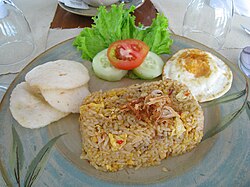
Indonesian cuisine is a collection of various regional culinary traditions that formed the archipelagic nation of Indonesia. There are a wide variety of recipes and cuisines in part because Indonesia is composed of approximately 6,000 populated islands of the total 17,508 in the world's largest archipelago, with more than 300 ethnic groups calling Indonesia home. Many regional cuisines exist, often based upon indigenous culture with some foreign influences. Indonesia has around 5,350 traditional recipes, with 30 of them considered the most important. Indonesia's cuisine may include rice, noodle and soup dishes in modest local eateries to street-side snacks and top-dollar plates.

Fried rice is a dish of cooked rice that has been stir-fried in a wok or a frying pan and is usually mixed with other ingredients such as eggs, vegetables, seafood, or meat. It is often eaten by itself or as an accompaniment to another dish. Fried rice is a popular component of East Asian, Southeast Asian and certain South Asian cuisines. As a homemade dish, fried rice is typically made with ingredients left over from other dishes, leading to countless variations. Fried rice first developed during the Sui Dynasty in China and as such all fried rice dishes can trace their origins to Chinese fried rice.
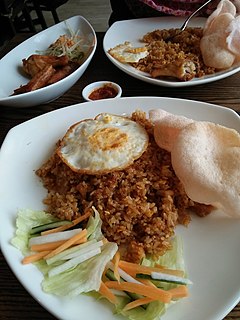
Nasi goreng, literally meaning "fried rice" in both the Indonesian and Malay languages, is an Indonesian rice dish with pieces of meat and vegetables added. It can refer simply to fried pre-cooked rice, a meal including stir fried rice in a small amount of cooking oil or margarine, typically spiced with kecap manis, shallot, garlic, ground shrimp paste, tamarind and chilli and accompanied by other ingredients, particularly egg, chicken and prawns. There is also another kind of nasi goreng which is made with ikan asin which is also popular across Indonesia. Nasi goreng is sometimes described as Indonesian stir-fried rice, although it is also popular in Southeast Asia. Beyond the Malay Archipelago, it has gained popularity through Indonesian influence in Sri Lanka and via Indonesian immigrant communities in Suriname and the Netherlands. It is distinguished from other Asian fried rice recipes by its aromatic, earthy and smoky flavor, owed to generous amount of caramelised sweet soy sauce and powdered shrimp paste, and the taste is stronger and spicier compared to Chinese fried rice.

Mie goreng, also known as bakmi goreng, is an often spicy fried noodle dish, originating from Indonesia, common in Malaysia, Brunei Darussalam, and Singapore. It is made with thin yellow noodles stir fried in cooking oil with garlic, onion or shallots, fried prawn, chicken, beef, or sliced bakso (meatballs), chili, Chinese cabbage, cabbages, tomatoes, egg, and other vegetables. Ubiquitous in Indonesia, it is sold by food vendors from street-hawkers, warungs, to high-end restaurants. It is an Indonesian one-dish meal favourite, although street food hawkers commonly sell it together with nasi goreng. It is commonly available at Mamak stalls in Singapore, Brunei, and Malaysia and is often spicy. In Sri Lanka, mee goreng is a popular dish due to Malay cultural influences and is sold at street food stalls around the country.
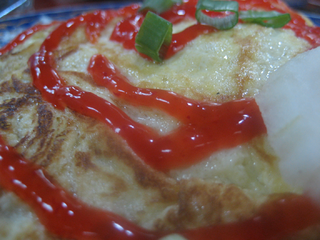
Nasi goreng pattaya, or simply nasi pattaya, is a Southeast Asian fried rice dish made by covering or wrapping chicken fried rice, in thin fried egg or omelette. Despite its name, the dish is believed to originate from Malaysia, and today is also commonly found in Indonesia and Singapore. It is often served with chili sauce, tomato ketchup, slices of cucumber, and keropok.

Javanese cuisine is the cuisine of Javanese people, a major ethnic group in Indonesia, more precisely the province of Central Java, Yogyakarta and East Java. Though the cuisine of Sumatra is known for its spiciness with notable Indian and Arabic influences, Javanese cuisine is more indigenously developed and noted for its simplicity. Some of Javanese dishes demonstrate foreign influences, most notably Chinese.

Tumpeng is an Indonesian cone-shaped rice dish with side dishes of vegetables and meat originating from Javanese cuisine of Indonesia. Traditionally featured in the slamatan ceremony, the rice is made by using a cone-shaped woven bamboo container. The rice itself may be plain steamed rice, uduk rice, or yellow rice.

Nasi kuning, or sometimes called nasi kunyit, is an Indonesian fragrant rice dish cooked with coconut milk and turmeric, hence the name nasi kuning.
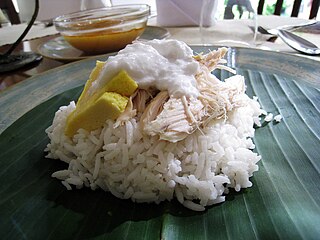
Nasi liwet is an Indonesian dish rice dish cooked in coconut milk, chicken broth and spices, from Solo, Central Java, Indonesia. Common steamed rice is usually cooked in water, but nasi liwet is rice cooked in coconut milk, chicken broth, salam leaves and lemongrass, thus giving the rice a rich, aromatic and succulent taste. Nasi liwet is a traditional Javanese way of cooking rice in coconut milk. There is one variant of liwet rice, the style of Nasi Liwet Sunda from West Java with its unique Sundanese cuisine a different taste and presentation from Sundanese eating tradition called ngeliwet or botram.

Sundanese cuisine is the cuisine of the Sundanese people of West Java, Indonesia. It is one of the most popular foods in Indonesia. Sundanese food is characterised by its freshness; the famous lalab eaten with sambal and also karedok demonstrate the Sundanese fondness for fresh raw vegetables. Unlike the rich and spicy taste, infused with coconut milk and curry of Minangkabau cuisine, the Sundanese cuisine displays the simple and clear taste; ranged from savoury salty, fresh sourness, mild sweetness, to hot and spicy.

Semur is an Indonesian type of meat stew, that is braised in thick brown gravy commonly found in Indonesian cuisine. The main ingredient used in semur gravy is sweet soy sauce, shallots, onions, garlic, ginger, candlenut, nutmeg and cloves, sometimes pepper, coriander, cumin and cinnamon might be added.

Nasi timbel is an Indonesian hot dish, consisting of steamed rice wrapped inside a banana leaf. It is a traditional Sundanese cuisine from West Java. The heat of the hot-cooked rice touches the banana leaf and produces a unique aroma. It is made in ways similar to making lontong; compressed, rolled, and wrapped in banana leaves; it then evolves into a complete dish served with various side dishes such as fried chicken, empal gepuk, jambal roti, tahu goreng, tempeh, salted duck egg, sayur asem, with lalab and sambal. Nasi timbel later evolved to nasi bakar.

Lontong Cap Go Meh is a Chinese Indonesian take on traditional Indonesian dishes, more precisely Javanese cuisine. It is lontong rice cake served with richly-flavoured dishes which includes opor ayam chicken in coconut milk, sayur lodeh vegetables soup, hot and spicy liver, hard boiled pindang egg, koya powder made of soy and dried shrimp or beef floss, pickles, chili paste and prawn cracker. Lontong cap go meh usually consumed by Chinese Indonesian community during Cap go meh celebration.

Ayam penyet is Indonesian — more precisely East Javanese cuisine — fried chicken dish consisting of fried chicken that is smashed with the pestle against mortar to make it softer, served with sambal, slices of cucumbers, fried tofu and tempeh. In Indonesia penyet dishes, such as fried chicken and ribs are commonly associated with Surabaya, the capital city of East Java. The most popular ayam penyet variant is ayam penyet Suroboyo.
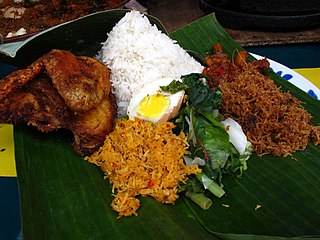
Nasi ambeng or Nasi ambang is an Indonesian fragrant rice dish that consists of - but is not limited to - steamed white rice, chicken curry or chicken stewed in soy sauce, beef or chicken rendang, sambal goreng urap, bergedel, and serunding.

Krechek or krecek or sambal goreng krechek is a traditional Javanese cattle skin spicy stew dish from Yogyakarta and Central Java, Indonesia. Traditionally it is made from the soft inner skin of cattle, however the most common recipe today uses readily available rambak or krupuk kulit.

Betawi cuisine is rich, diverse and eclectic, in part because the Betawi people that create them were composed from numbers of regional immigrants that came from various places in the archipelago, as well as Chinese, Indian, Arab, and European traders, visitors and immigrants that were attracted to the port city of Batavia since centuries ago.

Sambal is an Indonesian chili sauce or paste typically made from a mixture of a variety of chili peppers with secondary ingredients such as shrimp paste, garlic, ginger, shallot, scallion, palm sugar, and lime juice. Sambal is an Indonesian loan-word of Javanese origin (sambel). It is native to the cuisines of Indonesia, and popular in Malaysia, Sri Lanka, Brunei and Singapore. It has also spread through overseas Indonesian populations to the Netherlands and Suriname.

Mie Jawa is a traditional Indonesian-Javanese style noodle, commonly found in Indonesia and Malaysia. The dish is made of yellow noodle, chicken, vegetables, egg and spices. The recipe however, is slightly different between mie Jawa in Indonesia and mee Jawa in Malaysia.

Nasi tutug oncom or sometimes simply called tutug oncom, is an Indonesian style rice dish, made of rice mixed with oncom fermented beans, originally from Tasikmalaya, West Java. It is usually wrapped in banana leaves and served with various side dishes.
